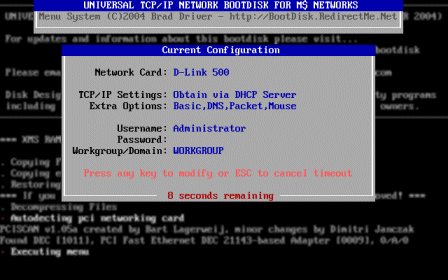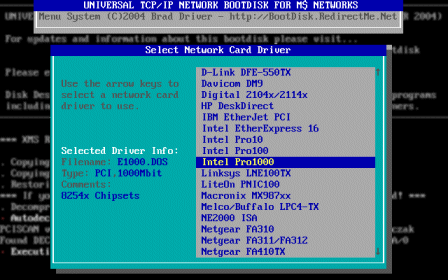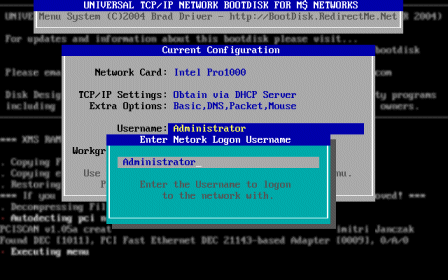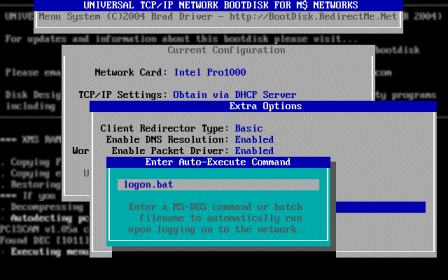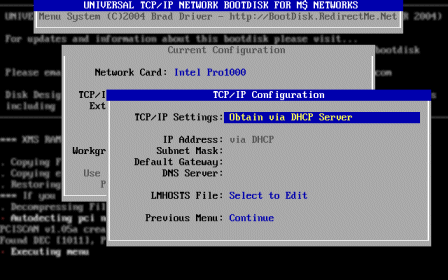

The Universal TCP/IP Network Bootdisk is a DOS bootdisk that provides TCP/IP networking support. It's designed for use in Microsoft networking environments, on either peer-to-peer or domain based LANs. Currently 98 different network card drivers all included, all on the single 1.44MB disk! Most people use this bootdisk for "Ghosting" PC's over a network connection. This disk will provide the DOS networking and drivers to allow the mapping of a network drive containing your imaging software and files. TCP/IP based image transfers, like GhostCast is also supported!
About the Disk
The Universal TCP/IP Network Boot Disk is a DOS bootdisk that provides TCP/IP networking support. It's designed for use in Microsoft networking environments, on either peer-to-peer or domain based LANs. Currently 98 different network card drivers all included, all on the single 1.44MB disk!
Most people use this bootdisk for "Ghosting" PC's over a network connection. This disk will provide the DOS networking and drivers to allow the mapping of a network drive containing your imaging software and files. TCP/IP based image transfers, like GhostCast is also supported.
Version 6.5 now contains 98 different network card drivers all on the single 1.44MB disk! However even more cards are supported, since many of these drivers are generic, supporting a entire chipset/series of cards! Upon booting the disk, the network card will attempt to be auto detected. Should it not be automatically detected the last manually selected card will be used. The current settings are then shown on the screen where you then can select to change the settings if you wish. This screen is set with an automatic timeout, so the disk can be used in a completely automated process.
Features Include
- Fully automatic, single floppy disk operation
- 98 Drivers included on the same single 1.44MB disk! - Supporting LOTS of cards!
- Easy to use Menu Interface
- Autodetection of PCI network cards
- DHCP or static IP configuration
- Included/Optional DNS Support
- Included/Optional DIS_PKT9 Packet Driver, allowing DOS TCP/IP Apps, including Ghost Multicasting!
- Included/Optional Mouse Driver
- Included/Optional IDE CD-ROM Driver
- Random computer name upon each boot (optional) Ideal for quickly booting multiple machines at once.
- Menu preferences, including last non-autodetected network card saved to disk as defaults for next boot
- Password saved encrypted to disk.
- Ability to auto-execute command upon logging on to the LAN.
- Scripting support for automatically running NTFS-DOS
- LMHOSTS Support
- Freeware DOSKEY included
- Terse 4096 byte Text Editor included
- Able to display the MAC address
- No hard drive required!
Typical Usage Scenarios
- Hard Disk Cloning - Get the machine on the network, then image the HDD from a remote network share. Or use the disk to map to a network share containing ghost.exe then join a multicast session from there! (3rd party imaging software not included)
- Gaining network access in DOS so you can recover data from FAT based partitions before formatting dead Windows installs
- Testing the network connection - Can't get network access? Not sure if it's a hardware or software problem? Isolate windows by seeing if the bootdisk works!
- Using an old PC without a HDD to run an DOS application off a network share.
2014 Note: I first started creating the NetBootDisk back in 2001 - in the height of re-imaging many machines from DOS/Windows 98 to Windows XP. Today I use more modern tools via PXE Booting - not to mention the machines don't even have floppies any more! :)
Computer Requirements
- 16MB RAM
- A supported network card/chipset
- An existing bootable disk made from Windows XP or PC-DOS 7
Screen Captures
Here are some very old screen captures! However 10 years later the interface is mostly the same...
